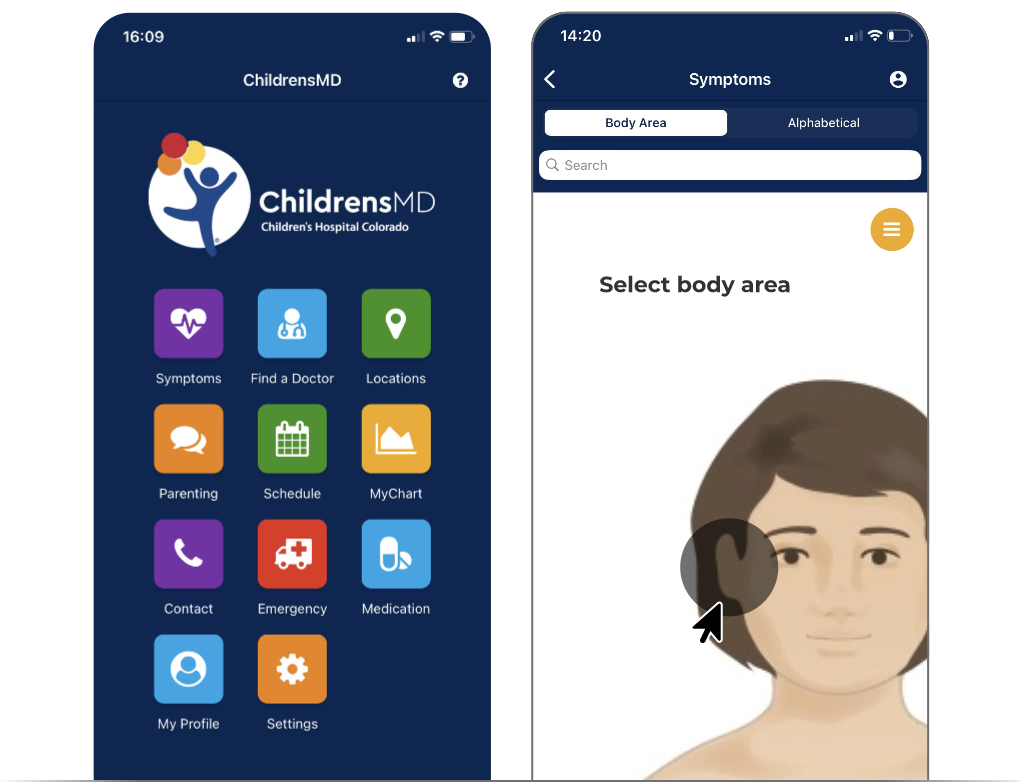- Doctors & Departments
-
Conditions & Advice
- Overview
- Conditions and Symptoms
- Symptom Checker
- Parent Resources
- The Connection Journey
- Calm A Crying Baby
- Sports Articles
- Dosage Tables
- Baby Guide
-
Your Visit
- Overview
- Prepare for Your Visit
- Your Overnight Stay
- Send a Cheer Card
- Family and Patient Resources
- Patient Cost Estimate
- Insurance and Financial Resources
- Online Bill Pay
- Medical Records
- Policies and Procedures
- We Ask Because We Care
Click to find the locations nearest youFind locations by region
See all locations -
Community
- Overview
- Addressing the Youth Mental Health Crisis
- Calendar of Events
- Child Health Advocacy
- Community Health
- Community Partners
- Corporate Relations
- Global Health
- Patient Advocacy
- Patient Stories
- Pediatric Affiliations
- Support Children’s Colorado
- Specialty Outreach Clinics
Your Support Matters
Upcoming Events
Colorado Hospitals Substance Exposed Newborn Quality Improvement Collaborative CHoSEN Conference (Hybrid)
Monday, April 29, 2024The CHoSEN Collaborative is an effort to increase consistency in...
-
Research & Innovation
- Overview
- Pediatric Clinical Trials
- Q: Pediatric Health Advances
- Discoveries and Milestones
- Training and Internships
- Academic Affiliation
- Investigator Resources
- Funding Opportunities
- Center For Innovation
- Support Our Research
- Research Areas

It starts with a Q:
For the latest cutting-edge research, innovative collaborations and remarkable discoveries in child health, read stories from across all our areas of study in Q: Advances and Answers in Pediatric Health.


Blisters
Get Care Now
From emergency to urgent care to 24/7 pediatric advice, we’re here to help in the heat of moment.
- Raised pocket of fluid (usually clear) covered by skin
- Friction Blister: friction blisters usually occur on the palms, fingers, heels or toes.
- Blood Blister: raised pocket of bloody fluid, covered by skin. Dark red or purple in color. A blood blister can occur when the skin gets pinched (in a hinge or a closing door).
- Blisters when the cause is unknown are also covered.
Causes of Blisters
- Friction Blisters. Friction is the most common cause of blisters.
- Burns - Chemical (Second-degree)
- Burns - Thermal (Second-degree)
- Frostbite (Second-degree)
- Hand-Foot-and-Mouth Disease. Viral rash from Coxsackie virus gives tiny blisters on palms and soles.
- Impetigo. Staph bacteria can cause impetigo with blisters.
- Insect Bites. In young children, insect bites (such as fleas) can cause small blisters.
- Poison Ivy, Poison Oak, Poison Sumac
- Sunburn (Second-degree)
- Staph Scalded Skin Syndrome (Serious). SSSS is caused by the Staph bacteria. The main finding is widespread large blisters.
Friction Blisters - Hands and Feet
- Friction causes most blisters on the hands and feet.
- A friction blister is a raised pocket of clear fluid covered by skin.
- Cause. A friction blister is the result of forces on the skin. Shear forces separate the top layer of the skin from the lower layer. This forms a cushion (blister) of fluid over the spot of friction or pressure.
- Common Sites. Fingers, palm, back of heel, top of toes, side of foot.
- Hand Friction Blisters. Hand blisters are often due to friction from using a tool too much. Examples are a shovel, pick, or rake. They can also be caused by sports equipment. Examples are a tennis racquet or boat oars. Gymnastics equipment (such as high bars) may also cause hand blisters.
- Foot Friction Blisters. Foot blisters are likely due to friction from an activity. Examples are hiking or running. Usually, a child has new shoes or poorly-fitting shoes. Children starting a new sport may develop blisters. Also, a risk factor to forming blisters is recently increasing the activity time.
- Prevention. There are two general approaches to prevent friction blisters. These are toughening the skin and lowering the friction force.
- Complications. Pain or infection.
- Treatment. Painless or mildly painful small blisters can be treated at home. Use moleskin or tape that has a hole cut in the center. Larger or very painful blisters sometimes need to be drained. This can be done by making a small hole in the blister. Use a clean needle or pin. Let all the blister fluid drain out. Then the blister can be covered with antibiotic ointment and a dressing.
Call Doctor or Seek Care Now
- Fever and looks infected (spreading redness)
- Widespread blisters
- Cause not clear and blisters on face
- Your child looks or acts very sick
- You think your child needs to be seen, and the problem is urgent
Contact Doctor Within 24 Hours
- Looks infected (spreading redness or pus)
- Severe pain and you want your doctor to drain the blister
- Cause not clear and blister on one or more finger pads
- Cause not clear and new blisters are developing
- You think your child needs to be seen, but the problem is not urgent
Contact Doctor During Office Hours
- No new blisters but cause not clear
- You have other questions or concerns
Self Care at Home
- Normal blister from friction
- Normal blood blister from pinch injury to skin
- Questions about prevention of foot blisters from hiking or running
- Questions about prevention of hand blisters from sports or tools
Care Advice
Treatment of Normal Friction Blister
What You Should Know - Friction Blister:
- A friction blister is a raised pocket of clear fluid, covered by skin.
- Most blisters should not be opened. Reason: it increases the risk of infection.
- However, large or severely painful blisters often need to be drained. This is done by poking a small hole in the blister with a needle. (see Severe Pain - Drain the Blister below)
- Here is some care advice that should help.
Protect the Blister:
- Goal: protect the blister from any more rubbing.
- Surround it with a "donut" made from moleskin. Ask for this product at your drug store.
- Using scissors, cut a moleskin piece to a shape larger than the blister.
- Next cut a hole the size of the blister in the center. Do this by folding the moleskin in half and cut along the fold.
- Remove the covering from the sticky side. Then, put the moleskin on with the blister in the center.
- If the blister is taller than the moleskin, add one more layer of moleskin.
- Hold the "donut" in place with a large strip of duct tape.
- Other option. If you don't have moleskin, use a bandage. Fold it and cut the center out to the size of the blister.
- For foot blisters, also switch to shoes that don't rub the blister.
Pain Medicine:
- To help with the pain, give an acetaminophen product (such as Tylenol).
- Another choice is an ibuprofen product (such as Advil).
- Use as needed.
Severe Pain - Drain the Blister:
- Draining a large blister can help make the pain go away.
- Wash the skin with warm water and soap.
- Clean a needle or straight pin with rubbing alcohol.
- Gently press the fluid to one side of the blister to create a bulge.
- Pass the needle sideways through the fluid making 2 puncture holes. Gently wiggle the needle to make the holes larger.
- Remove the needle.
- Press the fluid out through the holes.
- Leave the roof of the blister in place to protect the raw skin underneath.
- Use an antibiotic ointment (such as Polysporin). No prescription is needed. Put it on twice per day after cleansing.
- Cover the drained blister with a bandage.
Broken Blister Treatment:
- If the blister breaks open, let it drain.
- Leave the roof of the blister in place to protect the raw skin underneath.
- If there are any loose flaps of skin, trim them with a fine scissors.
- Wash it with warm water and soap.
- Use an antibiotic ointment (such as Polysporin). No prescription is needed. Put it on twice a day.
- Cover it with a bandage.
What to Expect:
- Most often, they dry up and peel off without any treatment.
- This may take 1 to 2 weeks.
Call Your Doctor If:
- Blister looks infected
- Severe pain and you want your child's doctor to drain the blister
- You think your child needs to be seen
- Your child becomes worse
Treatment of Normal Blood Blister
What You Should Know - Blood Blister:
- A blood blister can happen when the skin gets pinched. Examples are a finger caught in a hinge or a closing door.
- It forms a tiny pocket of bloody fluid covered by skin. It is dark red or purple in color.
- A blood blister is not harmful.
- No treatment is needed. You do not need to drain it.
- It will slowly dry up and peel off over 1-2 weeks.
Pain Medicine:
- To help with the pain, give an acetaminophen product (such as Tylenol).
- Another choice is an ibuprofen product (such as Advil).
- Use as needed.
Call Your Doctor If:
- You think your child needs to be seen
- Your child becomes worse
Prevention of Foot Blisters
Prevention - General:
- Shoes. Buy shoes that fit. Do not wear shoes that are too tight or too loose. New hiking boots are often somewhat stiff. It is wise to first wear them around the house and on short walks. Wear them in before wearing them on a long hike.
- Socks. Do not use cotton socks. They tend to stay damp when wearing. Instead use synthetic (acrylic) or wool socks. Some people prefer to wear two socks at a time. You can wear a thin inner liner ('wicking') sock and a thicker outer sock.
- Lubricants. If your child often gets blisters at the same spot, use a lubricant. You can use petroleum jelly (such as Vaseline). Cover the area with a small amount of the lubricant before sports. This will help to reduce friction on the spot.
- Callus. If blisters usually occur under a callus, file the callus down. Then, lubricate it. This way it won't add to the friction.
- Taping Pressure Points. If a lubricant doesn't stop blisters, taping is the next step. Taping is a very good way to treat hot spots for friction blisters. Many hikers and runners use taping. Follow the instructions listed down below.
Prevention - Taping:
- Option 1 - Moleskin
- You can get moleskin at your drug store. It is a good way to stop friction blisters. Here are some instructions on how to use moleskin.
- Using scissors, cut the moleskin to a shape slightly larger than the pressure point.
- Remove the backing from the moleskin. Put it on the pressure point. Smooth it from the center outward so that there are no wrinkles.
- Put on a clean and dry sock.
- Option 2 - Taping with Duct Tape
- Duct tape is available at your hardware store. It is also good at stopping friction blisters. Many hikers and runners use it. Here are some instructions on how to use duct tape.
- Using scissors, cut out a piece of duct tape into a shape slightly larger than the pressure point.
- Apply the piece of duct tape to the pressure point. Smooth it from the center outward so that there are no wrinkles.
- Put on a clean and dry sock.
Prevention - Toughening the Skin:
- This mainly applies to walkers, hikers, and runners.
- Slowly add to the distance you hike or run over days to weeks. This will increase the toughness of the skin. It will lower the risk of blisters forming.
Call Your Doctor If:
- You have other questions or concerns
Prevention of Hand Blisters
Prevention:
- Gloves. Wear heavy-duty work gloves when working with the hands. Also, use gloves when working with tools. Examples are shovels, picks, and rakes. Sports gloves can be used for rowing, paddling, weight lifting or cycling.
- Lubricants. Lower friction at pressure points by covering them with a lubricant. You can use petroleum jelly (such as Vaseline).
Call Your Doctor If:
- You have other questions or concerns
Copyright 2000-2024. Schmitt Pediatric Guidelines LLC.
Disclaimer: this health information is for educational purposes only. You, the reader, assume full responsibility for how you choose to use it.

Get to know our pediatric experts.



Carmelle Wallace, MD
Child Abuse Pediatrics, Emergency Medicine - Pediatric, Pediatrics
Patient ratings and reviews are not available Why?

Shane Wo, MD
Emergency Medicine - Pediatric, Pediatrics
Patient ratings and reviews are not available Why?



 720-777-0123
720-777-0123





